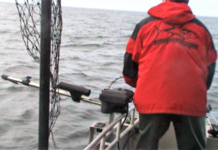
In areas of the ocean where sunlight does not penetrate, organisms such as these Riftia tubeworms seen along the Galapagos Rift have adapted to produce food through a process called chemosynthesis, which uses energy released by inorganic chemical reactions to produce food. Image courtesy of NOAA Okeanos Explorer Program.
Did You Know?
Most of our knowledge of the ocean lies in shallower waters. However, many fisheries are based in deep waters, as are new sites for offshore energy production and deep-sea mining. The deep sea may also hold cures to crippling diseases.
Even as the importance of deep areas of the ocean in our everyday lives continues to increase, our knowledge of these areas remains limited. In many instances, we are “flying blind” when it comes to management, regulation, and resource use in deep-water areas. NOAA’s Office of Ocean Exploration and Research is working to reduce unknowns in deep-ocean areas and provide the environmental intelligence needed to address science and management issues.
The bottom of the ocean is not uniform, which means water depths in the ocean also vary. The deepest place in the ocean measures 11,034 meters (36,201 feet) and is found in the Pacific Ocean’s Mariana Trench, at a place called Challenger Deep.
Because the ocean is a big place and difficult to study, if you search online to find the depth of the ocean, you may end up with a range of results.
The most-recent estimate of the average ocean depth of 3,682 meters (12,080 feet) was calculated in 2010 by scientists from Woods Hole Oceanographic Institution and NOAA using satellite measurements. These measurements revealed that the seafloor is much bumpier and mountainous than previously known and resulted in an average ocean depth that is less than previously calculated.
While satellite measurements have yielded better estimates of ocean depth than we have had in the past, rather than measuring the seafloor itself, satellites actually look at the sea surface and how it is changes over features like a mountain on the seafloor. So the picture of the seafloor scientists get is far from perfect and is not a very good resolution.
High-resolution seafloor mapping, such as that conducted on NOAA Ship Okeanos Explorer, is needed to fine tune the satellite data. Currently, we have only mapped about 10 percent of the Earth’s seafloor, meaning that estimates of average ocean depth remain just that: Estimates.
For More Information:
WHOI Study Calculates Volume and Depth of the World’s Oceans ![]() ~ Woods Hole Oceanographic Institution
~ Woods Hole Oceanographic Institution ![]()
On the Seafloor, Different Species Thrive in Different Regions (pdf, 3.6 Mb)
Mariana Arc ~ Submarine Ring of Fire 2004
Sign up for the Ocean Explorer E-mail Update List.














